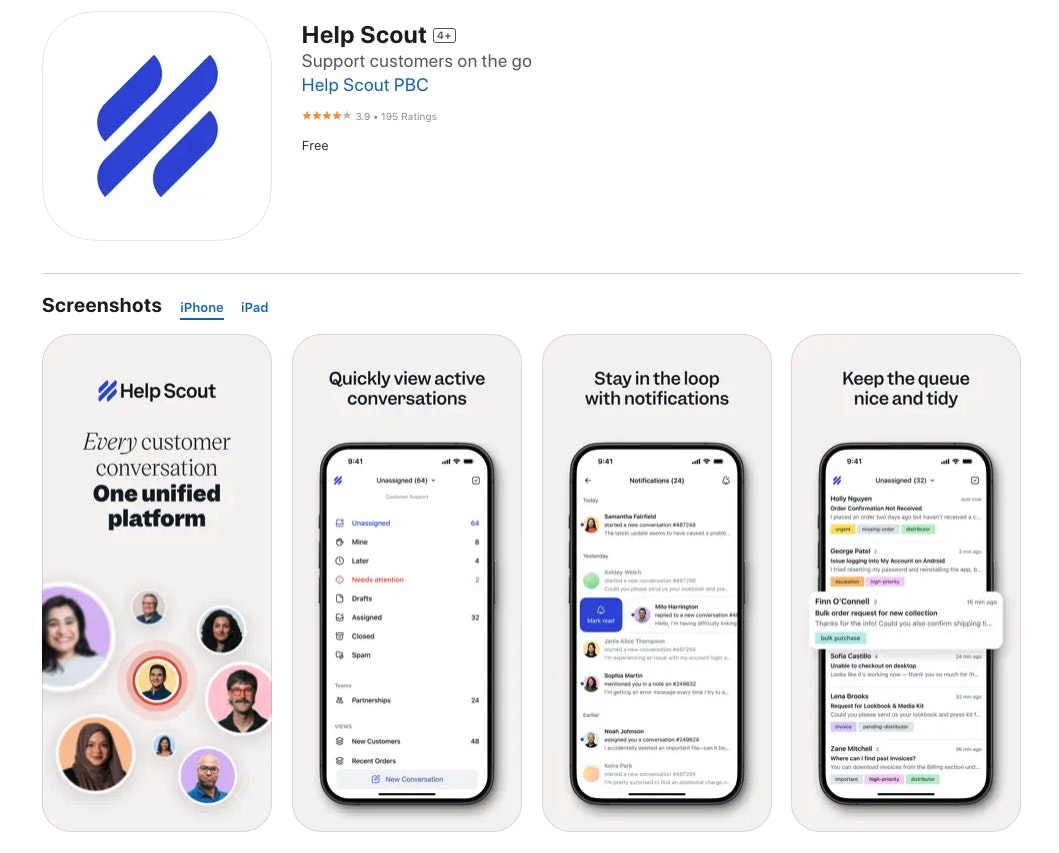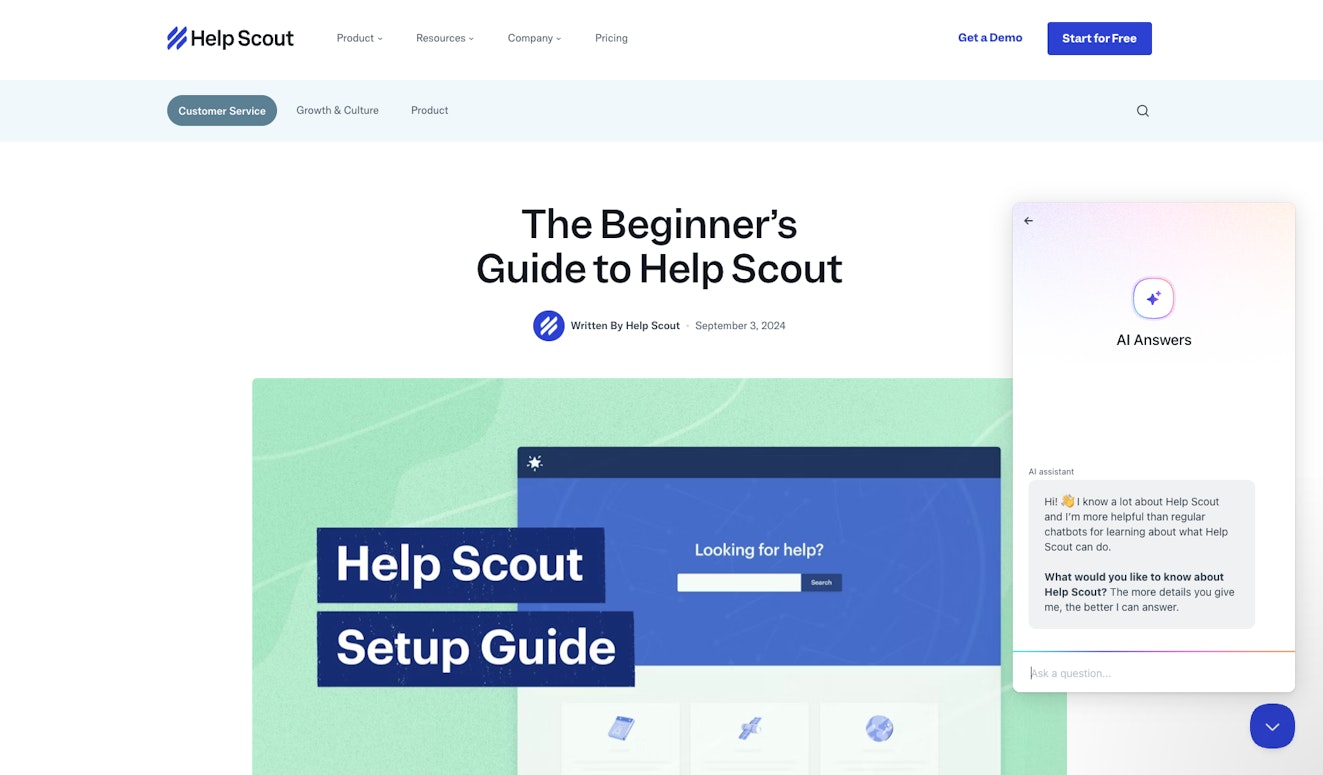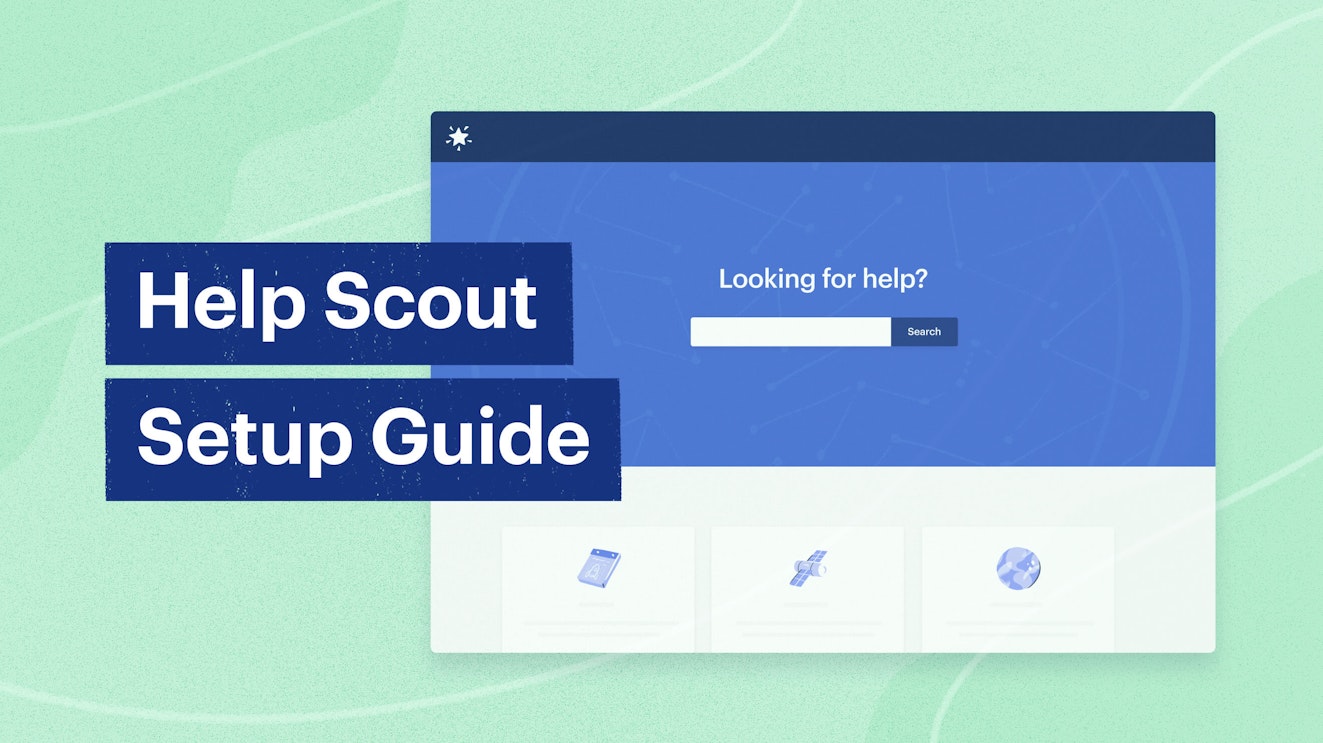If you’re just getting started with Help Scout and want to learn the basics, this guide is for you. Learn about the must-know features and follow the video tutorials to start getting the most out of Help Scout.
If you haven’t yet signed up, get started with a free trial.
Getting started: How to set up your Inbox
When you Log in to your Help Scout account, the first thing you will see is your dashboard — this is the hub for all of your customer service channels, and where you can view any shared inboxes you have access to.
A shared inbox is an email inbox that multiple users can access. It's beneficial for departments that receive and send a lot of emails (e.g., customer support, school admissions offices, medical groups, sales teams) as it keeps those communications from getting stuck in one person's personal inbox and allows teammates to work together to make sure that every message is getting a prompt response.
Think of it as where your team will receive and reply to emails sent to an address like support@ or contact@yourdomain.com
If you already have an email address that people use to send you or your team questions, you can set that up inside Help Scout. Watch this video tutorial to learn how:
Additional resources:
Setup instructions from common email tools, hosts, and help desks (including Outlook, Gmail, and GoDaddy)
Working inside your Inbox
How to manage conversations
Conversations are the communications you have with your customers in Help Scout. If you've been working with other systems, you might be used to calling them support tickets, phone call records, or just customer or client emails. In Help Scout, conversations come from email, live chat, and social media messages.
Watch this video to learn about Conversations — from replying to customers and using saved replies to collaborating with teammates:
More tips for managing conversations
Save time responding to a customer by using a Saved Reply — a prewritten response to common customer questions. Here’s how to create a library of answers to frequently asked questions.

Communicate and coordinate with your teammates using notes. It’ll help you keep track of all the internal information and decision-making that happens behind the scenes. Here’s a helpful resource on how to write a good internal note.
Prevent duplicate responses to customers with Collision Detection, a real-time indicator that shows when someone else is viewing or replying to a request. If you do try to send a reply — but someone else has already replied since you loaded the page — Collision Detection will automatically pause your response and let you see the update first.
Additional resources:
How to organize your inbox
How to manage tags
You can tag customer conversations to categorize types of requests, add context to a message, or keep track of certain topics in your inbox and eventually create detailed reports from them.
Read these step-by-step instructions or watch this two-minute video on how to create and manage tags.
How to organize using folders and inbox views
Folders and Inbox Views are great for sorting conversations in Help Scout. You can easily keep tabs on specific topics or problems and follow them through to resolution.
Each inbox comes with Default Folders: Unassigned, Mine, Needs Attention, and Drafts. You can also set up Inbox Views to organize your conversations based on specific conditions. This is helpful for things like monitoring time-sensitive, high priority, or VIP conversations.
Watch this video to learn more about how you can organize conversations using folders and views.
Pro-tip: If you’re a new employee at a company already using Help Scout, we recommend getting familiar with how your company organizes and labels their conversations.
Additional resources:
How to manage users
User roles and permissions
Users are anyone who needs to log in to your Help Scout account to communicate with customers or clients. Watch this video to learn more about the different user roles in Help Scout:
This article goes into more detail about user roles, including how to add or remove permissions, change user roles, or set custom permissions.
How to create and manage users
Follow these step-by-step instructions to learn how to:
Create new users
Manager user profiles, permissions, and settings
Delete users
Change user passwords
How to automate your inbox
In Help Scout, you can set up simple automations that take care of repetitive tasks using if/then logic using a feature called Workflows. Watch this video to learn more about workflows and the different ways you can use them:
Read this step-by-step guide on how to create and manage workflows, or check out this deeper class on workflows.
How to create reports
You can evaluate your team’s activity by channel, busiest hours, and trending topics among your customers. Watch this video to get an overview of Reports in Help Scout:
There are six types of reports (seven if you are using Docs) which can be viewed at any time via the Reports dropdown menu.
All Channels: This report can show total conversations, how busy you’ve been, conversation trends, most active customers, and which customers reach out the most. Learn more about the All Channels Report.
Email: This reports shows the number of email conversations, replies sent, resolves, resolved on first reply, emails created, messages received, and first response time. Learn more about the Email Report.
Chat: If you’re using Beacon to offer live chat on your website or in your app, this report helps you track chat volume, efficiency, and team productivity over time. Learn more about the Chat Report.
Phone: This report measures the volume of phone calls logged in Help Scout. Learn more about the Phone Report.
Company and user: This report shows how many customers you're helping, as well as how many replies you're sending on average. You can also drill down into the User report to see every single conversation your team members have engaged with, along with individual productivity metrics across the board. Learn more about the Company and user Reports.
Happiness: This report measures your customer experience based on satisfaction ratings. Evaluating satisfaction ratings and comments is a great way to identify trends in team performance. Learn more about the Happiness Report.
Docs: If you're using Docs, your customers are likely reading through your help articles before getting in touch. The Docs report helps you understand what your customers are searching for, what they're finding and not finding, as well as what percentage of customers are still sending an email after browsing. Learn more about the Docs Report.
Additional Resources:
Scaling with self-service support
Docs
Docs is our knowledge base feature (also known as a Help Center) where you create and store articles that answer all of your customers’ frequently asked questions. It keeps all of your available help documentation for your customers and your team in one place.
The information in your Help Center can also be used as a source for some of our AI features.
Watch this video to learn how to set up your Knowledge Base within Help Scout:
Additional resources:
Beacon
Beacon is an embeddable widget you can put on your website that helps you connect with customers and provide self-service support. It allows people to browse the docs in your knowledge base, send you an email or live chat message, and receive instant answers from a helpful AI-powered chatbot directly on your site.
It also allows you to offer proactive messaging anywhere a Beacon is installed.
Watch this video and read the information below to learn more about Beacon and its related features:
Live Chat: Providing live chat support gives your customers the option to get answers from your team in real time. Read this step-by-step guide on how to set up Live Chat.
AI Answers: Answers is an AI-powered chatbot that uses information from your knowledge base (and additional sources like your company website) to deliver instant answers to your customers and clients.
Messages: Messages give you the ability to proactively message visitors to your website. You can create certain triggers, such as the time on a page when a customer visits a specific URL. You can then assign actions like asking that customer to start a live chat. It can help achieve goals such as converting more customers, reducing support requests, and building a better business with targeted messages. Read this step-by-step guide on how to set up Messages.
Follow these instructions to set up your own Beacon.
Additional resources:
Going beyond the inbox
Mobile
The Help Scout mobile app is the best way to manage your Inbox while on the go. It’s designed to help you check what’s in the queue, reply to customers, assign conversations to teammates, and improve your response times.

With the Help Scout mobile app, you can:
Respond to customers quickly, including inserting saved replies.
Collaborate with teammates by adding notes, bringing people in as a CC/BCC, and assigning conversations.
Organize your queue by changing the status of conversations and using tags to categorize conversations or trigger automations.
Access all of your Help Scout Inboxes, folders, customer’s profile data, and conversation history.
Get direct, in-app contact with our support team in case you need any help.
How to Install the mobile app
iOS users: Download from the App Store
Android users: Download from the Google Play Store
How to use the mobile app
Additional resources:
Integrations
Help Scout integrates with more than 100 tools that help keep your business in sync — from CRM and analytics, to marketing and other support apps. Take a look at our integration app directory.
Watch this video to learn how to integrate with apps inside your Help Scout app:
Here's how to connect Help Scout with a variety of apps. If you don’t see a tool you need, Help Scout has an open API to work with your specific business needs.
Getting help from Help Scout
Live product walkthroughs
Every week we host live product walkthroughs where you can see exactly how Help Scout works. You can learn all about the platform and best practices and get your questions answered in real-time.
Knowledge base
Our Help Docs library has everything — product tutorials, step-by-step instructions, deep dives on all of our features and capabilities, and even some of our team’s favorite tips and tricks.
AI Answers
In addition to visiting our help center, you can click any Beacon on our site to access AI Answers and get your questions answered instantly.

Customer support
There are two main ways you can get in touch with our support team:
Email our support team at any time - help@helpscout.com. Our team is spread around the world and covers 24/6.
Send us a message via the “Contact Us” form on the bottom right corner of our Knowledge Base.






